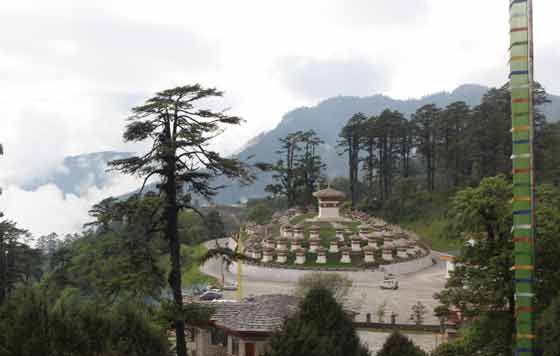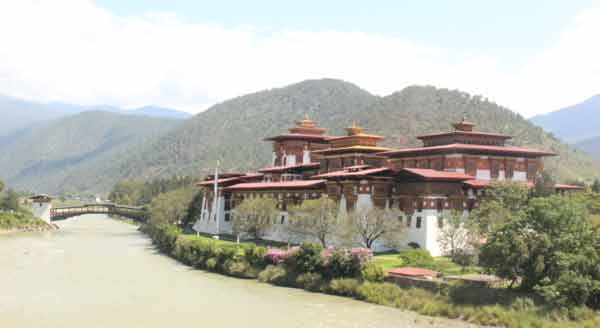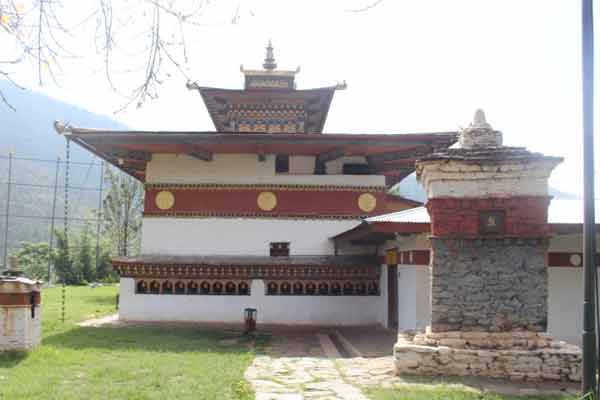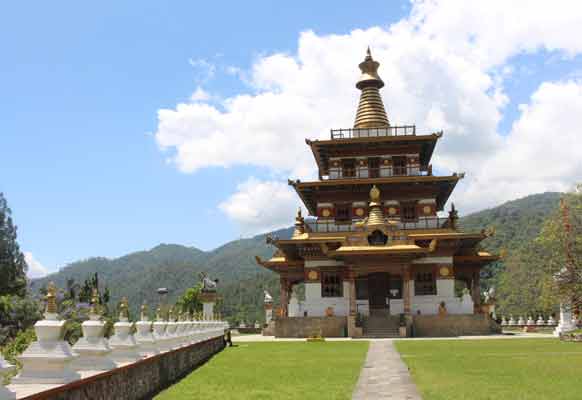The pictorial Punakha.
Punakha is located in the scenic and fertile valley in between the confluence of the Pho chu and Mo chu. And, Bang! in the center of the confluence is the Punakha dzong, perhaps one of Bhutan’s most impressive fortresses.
The low altitude of the valley allows for paddy to be grown and harvested twice a year. The fruits of all hues are in abundance. Bird lovers should keep their eyes peeled for the endangered White-bellied Heron. Of the global population of about 200, around 34 are found in Bhutan which can be spotted in Punakha valley.
The drive from Thimphu valley to Punakha is quite spectacular as the road meanders through the beautiful Dochu la Pass. It offers the awe inspiring opportunity to view the great Himalayan mountain ranges.

The panoramic Dochula Pass.
Tourist attractions in Punakha:
1. Punakha dzong:
Standing majestically at the confluence of the Pho chu and Mo chu rivers, the dzong (fortress) was constructed in 1637-38 and is the second oldest dzong in the Kingdom. The dzong houses the sacred relics of the southern Drukpa Lineage of the Kagyu school of Tibetan buddhism, including the Rangjung Kharsapani and the sacred remains of Ngawang Namgyal and the Terton Pema Lingpa. It was the administrative centre and the seat of the Bhutanese government until 1955, when the capital was moved to Thimphu valley. Today, it is still the winter residence of the Je Khenpo (The chief abbot of Bhutan) and the monastic body of Bhutan. Set against a spectacular backdrop, the architecture of the dzong is simply awe inspiring. It was in Punakha dzong that the wedding of His Majesty King Jigme Khesar Namgyel Wangchuck and Her Majesty Queen Jetsun Pema was held on October 13, 2011.

The majestic Punakha dzong.
2. Chimi lhakhang:
Of all the religious figures of Bhutan, perhaps no one is as popular as Drukpa Kuenley or “The divine madman”. The maverick saint was so revered that a temple – Chimi lhakhang (Popularly called The temple of fertility) was built in his honor. Legend has it that Drukpa Kuenley subdued a demon of the region with his ‘Magic thunder bolt of wisdom’ and trapped it in a rock close to where the lhakhang now stands. He is known as “The divine madman” for his unorthodox ways of teaching Buddhism often with sexual overtones. He is also the saint who advocated the use of phallus symbols that even today adorn Bhutanese paintings and houses.
The temple is believed to bless couples who seek fertility and children. This temple is the repository of the original wooden phallus that he brought from Tibet. It is used to bless people who visit the temple on pilgrimage, particularly women seeking blessing to beget children. This site is also the main highlight of honeymoon tour in Bhutan.

Chimi lhakhang, the temple of fertility.
3. Khamsum Yulley temple:
A short hike from the main road takes one to the Imperial Khamsum Yulley temple. This temple is built on a hill top overlooking the valley below. It was built to remove negativity and promote peace, stability and harmony in the changing world. The temple dominates the upper part of valley with commanding views across the Mo chu and up towards the mountainous peaks of Gasa and beyond. (One of the main highlights of Photography tour in Bhutan).

The Imperial Khamsum Yulley monastery.
4. Talo village:
The village of Talo sits at an altitude of 2,800 m and is scattered along the slopes of a hill and is famed for its cleanliness and hygiene. Also, the women of Talo are particularly known for their striking good looks. The Talo monastery overlooks the Punakha valley as it sits on a mountain ridge. For centuries, this ancient spiritual center has stood guard over the valley below. The monastery was founded in 1767, in the year of the fire pig, according to the Bhutanese calendar.
5. Nalanda Buddhist college:
Nalanda Buddhist Institute also known as Dalida or “Daley”. It is a Drukpa Kagyu School situated in the western region of the valley. In the native language the word “Nalanda” stands for endless knowledge. The college was founded in the year 1957 by the 9th Je Khenpo (The chief abbot of Bhutan), Shakya Rinchen. For visitors, this institute with its religious and historic influence has become one of the must visit places in the Bhutan.
6. Sangchhen Dorji Lhuendrup nunnery:
This nunnery on a hilltop overlooking the beautiful Punakha and Wangdue Phodrang valleys is surrounded by rich lush green pine forests. The nunnery complex is a true expression of Bhutanese architecture portraying strong traditional values.
It was built as a buddhist college for nuns and currently houses about 120 nuns. The nunnery complex also houses a meditation centre for nuns. Apart from religious schooling, the centre also strives to provide life skills such as tailoring, embroidery, sculpting and Buddhist Thangka painting.
Tourists can take advantage of the tranquil ambience and immerse in meditation programs. One can also take the opportunity to observe the spiritual lives of nuns while they learn and prepare themselves for life with a variety of skill trainings.
7. Limbukha village:
This village is easily accessible through feeder roads from Punakha and Wangdue Phodrang. The village provides some spectacular views of the Punakha dzong and the Mo chu and Po chu rivers.
The people of this village are also known for its love of peace. Legend has it that during medieval wars, the people of this village always volunteered as peace negotiators. This is also depicted during the annual festival called ‘Serda’ when the men carry peace flags instead of swords and fireworks. Walk from Punakha to this beautiful village will take about 4 to 6 hours and the distance is 14 km.
8. Ritsha village:
Ritsha which literally translates to at the base of a hill. This village situated along the banks of Pho chu and Mo chu looks straight out of a postcard. Famous for its production of red and white rice, it is surrounded by paddy fields, meandering rivers and looming hills.
From taking a stroll along the paddy fields and learning about traditional and modern farming methods used in the village, to trekking, mountain biking and white water rafting, there are a bunch of things one can do in this village.
9. Lungchutse hike:
The 7 km round trip from Dochu la pass to Lungchutse temple is without a doubt the best hike in the area. The hike offer excellent views of the Himalayas mountain ranges. From the 108 chortens in Dochu la, the trail climbs gradually through beautiful rhododendron forests before branching left to the temple. This 18th century temple was founded by the treasure hunter, Drakda Dorji and is dedicated to the local protector, Tashi Barwa. The visitors can combine the hike with dawn views from Dochu la for a great half day excursion.
10. Tashigang Goemba hike:
This hike can be easily combined with the Lungchutse Goemba one for a fine half-day walk. It is an easy 60 minute downhill stroll from Lungchutse. Trashigang Goemba was built in the year 1782 by the 12th Je Khenpo. This temple is an important meditation center for around 60 monks and a few nuns. In the main chapel, visitors can ask to see the small chorten that encases a tiny statue made from the tooth of the 22nd Je Khenpo. The various chapels hold statues of 10 or more Je Khenpos who have meditated here over the years. The inner sanctum of the ground-floor goenkhang (chapel dedicated to protective deities) is said to conceal the preserved flesh of the goddess Palden Lhamo.
From the goemba, it is a steep one-hour direct descent to Hongtsho on the Thimphu–Punakha highway.
11. Rinchengang village:
This village is perhaps the most clustered village in Bhutan. Also, it is one of the oldest villages in Bhutan as it dates back to the Shabdrung era.
The settlers in the village, back in the day, were skilled in the traditional method of stone masonry. And so, it was them who built the old Wangdue Phodrang dzong that stood for over 480 years before a fire gutted it a few years back.
In earlier times, the place was known as ‘Drinchen-Gang’ meaning ‘Grateful valley’. Grateful for the contributions the people there made in building the dzong. With time, Drinchen gang changed to Rinchengang as we know it today. To get to the village, it is a 20-minute uphill walk from the road head.
